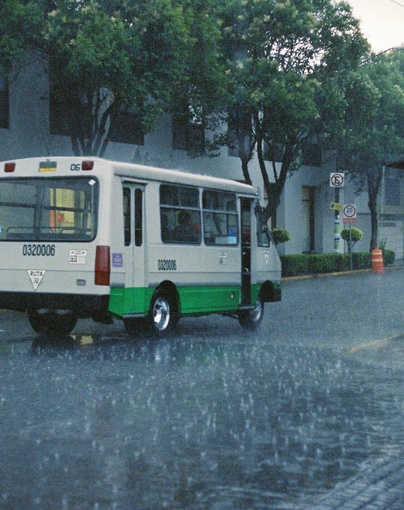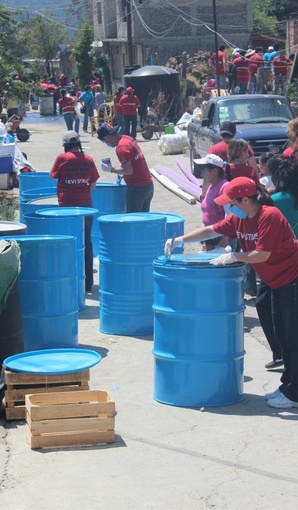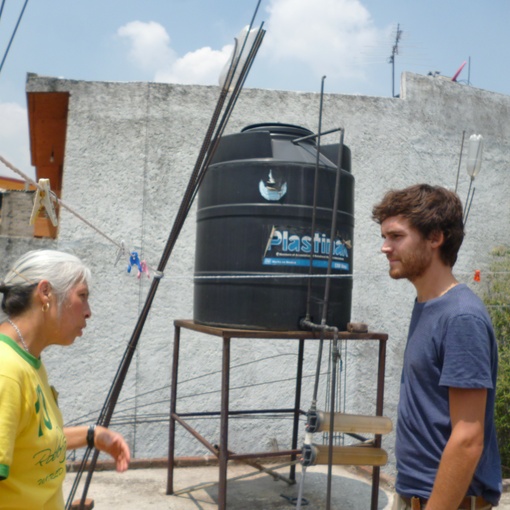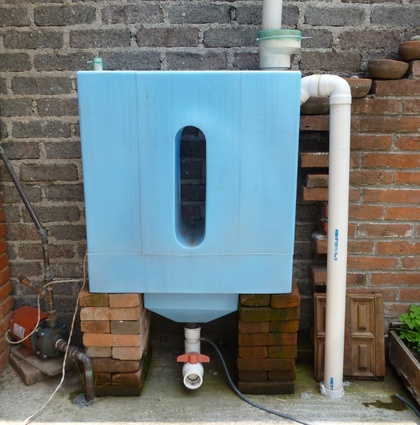
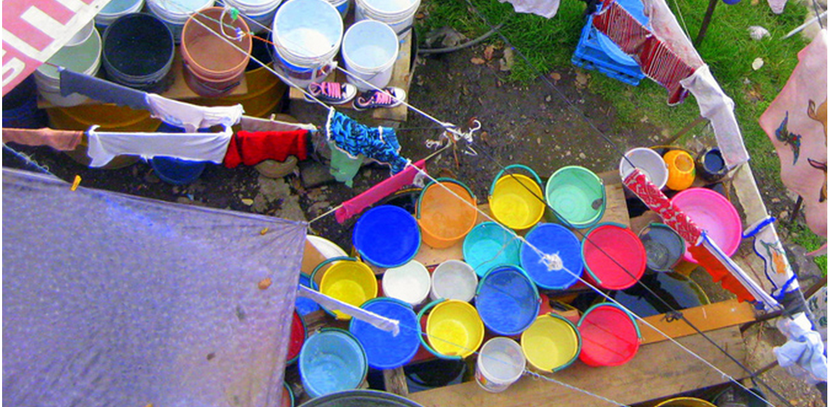
"We never know when water is going to come", explains Patricia as we stand on her roof one sunny afternoon in mid-June, "I have gone for 4 weeks without any". Patricia lives on the very edge of Mexico City, a resident of one of its many sprawling informal suburbs. The population is now close to 22 million making it the 5th most populated city in the world, and, due to poor infrastructure and over-exhaustion of resources, Mexico's capital is suffering a water crisis.1 Responding to this multi-faceted problem, a local group of young engineers, urbanists and ecologists are using innovative design to promote rainwater captivation as an environmental, economic and social solution to the crisis.
To fully understand the water problem in Mexico City the geography of the megapolis first needs to be understood. Mexico City, or DF (Distrito Federal) as its residents know it, stands at about 2,200 metres and has been built on a lake-bed that was drained by the Spanish in the 16th Century. Tenochtitlan, the Aztec city that once thrived on the lake, was a maze of canals, dams, bridges and causeways, inhabited by an estimated 200,000 people. The draining that began with the Spanish continues today, with 70% of the city's water pumped into the mains system from the ground below the Valle de Mexico, and is causing Mexico City to sink at a rate of one metre every 10 years.2
The sinking of the city is damaging the old and ineffective pipe system that transports water to households citywide. This is creating yet another compounding issue to the water crisis; up to 40% of water that is taken from the ground, rivers and reservoirs is lost in leakage before it reaches the taps of people like Patricia.3 Even starker is the economic and environmental wastage that comes from the supply of the other 30% of Mexico's water, which comes from Lerma-Cutzamala, Veracruz, pumped from rivers, lakes and reservoirs over a distance of 200 kilometres, and more worryingly ascends over 1000 metres. The amount of electricity needed to pump this water annually is outstanding: a third of the cityís total electricity use, or the equivalent of all electricity used in London.4
It is estimated that now more than 36% of homes in Mexico City do not have constant access to mains water,5 and this predictably disproportionately affects poorer, informal or marginalised communities. Some areas lack mains water entirely - there is no water infrastructure, and at times the water in the pipes is of very poor quality. Despite this lack of access to a regular clean water supply, each year during the rainy season Mexico City suffers huge floods as the rains wash off the sprawling concrete and run rivers down its streets, creating further economic and social problems. In summary, millions of people lack good water supply, while rainwater is flooding the city's streets.
Rainy season in Mexico City, Danielle House, 2013
Enter stage right Isla Urbana, a civil association working in one of DF's informal neighbourhoods, designing and installing rainwater harvesting systems that are appropriate for the local houses, affordable to run and easy to use. Isla Urbana, headed up by Director Enrique Lomnitz, live and work in the Colonia Cultura Maya, Delegación Tlalpan, in the very south of Mexico City. Tlalpan has experienced huge immigration mostly from rural Mexico as people flocked to the city for work. These informal communities boomed without basic infrastructure, and as such areas like Colonia Cultura Maya suffer severe water shortages. Isla Urbana moved to the neighbourhood and set up offices (and home) in 2009 and began prototyping their systems and installing them in their neighbours houses.
Patricia is one such neighbour, living a couple of blocks from the Isla Urbana home. Like most of the residents of Cultura Maya, when she moved there 20 years ago she simply built her house on the next empty plot on the edge of the city, which has since spread further up the hill. Patricia was one of the first households to have an early model rainwater harvesting system installed, and has just recently been updated with Isla's latest design, the Tlaloque, again being prototyped in the Cultura Maya.
The Tlaloque is extremely simple, a blue tank that collects and filters rainwater which is then pumped into a house (see Box 1 for details). Almost every house in these informal neighbourhoods has its own cistern with a pipe from the mains in the street directly connecting to each. Every house then has a pump to move water from their large cisterns to smaller water tanks on their roofs. Enrique explained to me that when he realised that the houses already had this infrastructure in place, (the most expensive part of rainwater harvesting), he understood how simple and affordable it would be to install the captivation systems.
Box 1: The Tlaloque
The Tlaloque, Danielle House, 2013
Rainwater capturing works alongside mains water. There are months in DF without rain, but the key to Isla Urbana's systems is that rainwater and mains water both flow into one cistern. Capturing some of this will greatly improve flooding by reducing runoff, will reduce electricity usage in pumping water, and will reduce the over exploitation of the ground water source in the Valle de Mexico, undermining the stability of the city. In fact, Isla Urbana estimate that if rainwater was captured on a large scale it could satisfy up to 50% of the city's water needs.
Patricia explained to me the difference rainwater harvesting had made to her life. "The cost of water from the government is so high. Then you never know when it is going to come! They say it will be there once a week, but you don't know which day or what hours. When the water is there you have to open your pipe to fill your cistern, but I have gone 2, 3 even 4 weeks without any". Once the rains start Patricia's 10,000 litre cistern is full in a few days, and Isla Urbana estimate that when a family begins to harvest rainwater with their system, their cistern is full for 6 months of the year with rainwater. The only cost to Patricia for her Tlaloque is her 2 filters, which last 6 months, and cost $100 pesos to replace them both, which is drastically less than the cost of mains water.
Patricia's rooftop water tank and filters, Danielle House, 2013
Isla Urbana functions as a civil association, however they have now set up a rainwater harvesting consultancy to work on large buildings and offices in the city as a way of establishing a regular income. The residential systems they install in Cultura Maya are subsidised heavily, ranging from free to anything that people can afford. They are additionally now working with the Delegación Tlalpan, the local authority, to subsidise and install more systems in the area. To date, Isla Urbana has installed 1,151 systems, which has helped 12,862 people, and harvested 54,400,000 litres of rainwater.6 They are currently installing 2 or 3 systems in the neighbourhood each day.
Isla Urbana is extremely tied to its local community; the founders live and work there. Across the delegación they have trained and employed local plumbers, improving the skill set of the community and providing local people with the knowledge to install and repair the captivation systems. They listen to their neighbours who have systems and work with them to improve design and functionality. The design process is collaborative; I observed the team working on a new idea, bouncing ideas off one another, using each individuals expertise and experience to come up with an effective and innovative simple design that is as cost effective as possible. They also focus heavily on community engagement with people who do not yet have systems, regularly holding free demonstrations, training and workshops, and free events for children such as painting murals.
Community event, Isla Urbana, 2013
There are examples of innovative organisations embedding themselves in local communities all over the globe. Other examples include the 'urban acupunctures' of Urban Think Tank in Caracas, Venezuela, and the Barcelona Urban Lab. Though Isla Urbana is working in a different context in remit and currently scale, the future for in-situ problem solving and 'live pilots' presents more possibilities for creativity and sustainability.
Although Mexico has very specific factors compounding its water crisis, problems of water supply in megacities is common. As cities globally continue to undergo growth at unprecedented levels - booming in population and urbanization - present water sources will become over exploited and exhausted, with an increase in flooding. Isla Urbana could be a model for an innovative and sustainable solution for cities, reducing environmental and social damage and utilising a water source for the foreseeable future. This community grown and community led scheme is making a huge difference locally in Colonia Cultura Maya, and has the potential to make a huge difference citywide and beyond.
1 Big Cities. Big Water. Big Challenges. Water in an Urbanizing World, WWF, 2011
2 www.islaurbana.org
3 Big Cities. Big Water. Big Challenges. Water in an Urbanizing World, WWF, 2011
4 www.islaurbana.org
5 www.islaurbana.org
6 www.islaurbana.org as of 31/08/2013
Cover photo: Buscando un futuro sustenable para nuestra comunidad, Isla Urbana, 2013
Written by Danielle House
Danielle House is Intern at Social Life. She spent the past year in Mexico and this article is based on a visit to Isla Urbana and recipients of their rainwater captivation systems.
